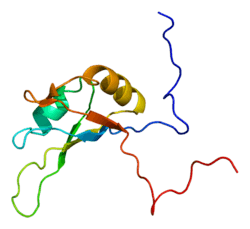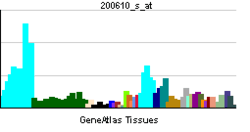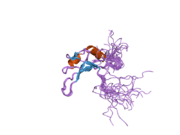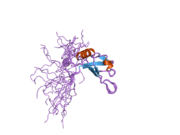Nucleolin
Nucleolin is a protein that in humans is encoded by the NCL gene.[1][2]
Gene
The human NCL gene is located on chromosome 2 and consists of 14 exons with 13 introns and spans approximately 11kb. The intron 11 of the NCL gene encodes a small nucleolar RNA, termed U20.[3]
Function
Nucleolin (NCL), a eukaryotic nucleolar phosphoprotein, is involved in the synthesis and maturation of ribosomes.[3] The protein is located mainly in dense fibrillar regions of the nucleolus.
Nucleolin is also able to act as a transcriptional coactivator with Chicken Ovalbumin Upstream Promoter Transcription Factor II (COUP-TFII).[4]
Clinical significance
Midkine and pleiotrophin bind to cell-surface nucleolin as a low affinity receptor. This binding can inhibit HIV infection.[5][6]
Nucleolin at the cell surface is the receptor for the Respiratory Syncytial Virus (RSV) fusion protein.[7] Interference with the nucleolin - RSV fusion protein interaction has been shown to be therapeutic against RSV infection in cell cultures and animal models.[8][9][10]
Interactions
Nucleolin has been shown to interact with:
References
- ↑ Srivastava M, McBride OW, Fleming PJ, Pollard HB, Burns AL (Sep 1990). "Genomic organization and chromosomal localization of the human nucleolin gene". The Journal of Biological Chemistry 265 (25): 14922–31. PMID 2394707.
- ↑ Erard MS, Belenguer P, Caizergues-Ferrer M, Pantaloni A, Amalric F (Aug 1988). "A major nucleolar protein, nucleolin, induces chromatin decondensation by binding to histone H1". European Journal of Biochemistry / FEBS 175 (3): 525–30. doi:10.1111/j.1432-1033.1988.tb14224.x. PMID 3409881.
- ↑ 3.0 3.1 "Entrez Gene: NCL nucleolin".
- ↑ Litchfield LM, Riggs KA, Hockenberry AM, Oliver LD, Barnhart KG, Cai J et al. (May 2012). "Identification and characterization of nucleolin as a COUP-TFII coactivator of retinoic acid receptor β transcription in breast cancer cells". PloS One 7 (5). doi:10.1371/journal.pone.0038278. PMC 3365040. PMID 22693611.
- ↑ Said EA, Krust B, Nisole S, Svab J, Briand JP, Hovanessian AG (Oct 2002). "The anti-HIV cytokine midkine binds the cell surface-expressed nucleolin as a low affinity receptor". The Journal of Biological Chemistry 277 (40): 37492–502. doi:10.1074/jbc.M201194200. PMID 12147681.
- ↑ Said EA, Courty J, Svab J, Delbé J, Krust B, Hovanessian AG (Sep 2005). "Pleiotrophin inhibits HIV infection by binding the cell surface-expressed nucleolin". The FEBS Journal 272 (18): 4646–59. doi:10.1111/j.1742-4658.2005.04870.x. PMID 16156786. Vancouver style error (help)
- ↑ Tayyari F, Marchant D, Moraes TJ, Duan W, Mastrangelo P, Hegele RG (Sep 2011). "Identification of nucleolin as a cellular receptor for human respiratory syncytial virus". Nature Medicine 17 (9): 1132–5. doi:10.1038/nm.2444. PMID 21841784.
- ↑ Mastrangelo P, Hegele RG (Nov 2012). "The RSV fusion receptor: not what everyone expected it to be". Microbes and Infection / Institut Pasteur 14 (13): 1205–10. doi:10.1016/j.micinf.2012.07.015. PMID 22884716.
- ↑ Mastrangelo P, Hegele RG (Mar 2013). "RSV fusion: time for a new model". Viruses 5 (3): 873–85. doi:10.3390/v5030873. PMID 23518574.
- ↑ Shakeri A, Mastrangelo P, Griffin JK, Moraes TJ, Hegele RG (Nov 2014). "Respiratory syncytial virus receptor expression in the mouse and viral tropism". Histology and Histopathology. Epub ahead of print. PMID 25374027.
- ↑ Li D, Dobrowolska G, Krebs EG (Jun 1996). "The physical association of casein kinase 2 with nucleolin". The Journal of Biological Chemistry 271 (26): 15662–8. doi:10.1074/jbc.271.26.15662. PMID 8663258.
- ↑ Dubois T, Zemlickova E, Howell S, Aitken A (Feb 2003). "Centaurin-alpha 1 associates in vitro and in vivo with nucleolin". Biochemical and Biophysical Research Communications 301 (2): 502–8. doi:10.1016/s0006-291x(02)03010-3. PMID 12565890.
- ↑ Tominaga K, Srikantan S, Lee EK, Subaran SS, Martindale JL, Abdelmohsen K et al. (Oct 2011). "Competitive regulation of nucleolin expression by HuR and miR-494". Molecular and Cellular Biology 31 (20): 4219–31. doi:10.1128/MCB.05955-11. PMC 3187287. PMID 21859890.
- ↑ Li YP, Busch RK, Valdez BC, Busch H (Apr 1996). "C23 interacts with B23, a putative nucleolar-localization-signal-binding protein". European Journal of Biochemistry / FEBS 237 (1): 153–8. doi:10.1111/j.1432-1033.1996.0153n.x. PMID 8620867.
- ↑ Daniely Y, Dimitrova DD, Borowiec JA (Aug 2002). "Stress-dependent nucleolin mobilization mediated by p53-nucleolin complex formation". Molecular and Cellular Biology 22 (16): 6014–22. doi:10.1128/mcb.22.16.6014-6022.2002. PMC 133981. PMID 12138209.
- ↑ Morimoto H, Okamura H, Haneji T (Sep 2002). "Interaction of protein phosphatase 1 delta with nucleolin in human osteoblastic cells". The Journal of Histochemistry and Cytochemistry 50 (9): 1187–93. doi:10.1177/002215540205000905. PMID 12185196.
- ↑ Sakaguchi M, Miyazaki M, Takaishi M, Sakaguchi Y, Makino E, Kataoka N et al. (Nov 2003). "S100C/A11 is a key mediator of Ca(2+)-induced growth inhibition of human epidermal keratinocytes". The Journal of Cell Biology 163 (4): 825–35. doi:10.1083/jcb.200304017. PMC 2173690. PMID 14623863.
- ↑ Fouraux MA, Bouvet P, Verkaart S, van Venrooij WJ, Pruijn GJ (Jul 2002). "Nucleolin associates with a subset of the human Ro ribonucleoprotein complexes". Journal of Molecular Biology 320 (3): 475–88. doi:10.1016/s0022-2836(02)00518-1. PMID 12096904.
- ↑ Haluska P, Saleem A, Edwards TK, Rubin EH (Apr 1998). "Interaction between the N-terminus of human topoisomerase I and SV40 large T antigen". Nucleic Acids Research 26 (7): 1841–7. doi:10.1093/nar/26.7.1841. PMC 147454. PMID 9512561.
- ↑ Bharti AK, Olson MO, Kufe DW, Rubin EH (Jan 1996). "Identification of a nucleolin binding site in human topoisomerase I". The Journal of Biological Chemistry 271 (4): 1993–7. doi:10.1074/jbc.271.4.1993. PMID 8567649.
- ↑ Khurts S, Masutomi K, Delgermaa L, Arai K, Oishi N, Mizuno H et al. (Dec 2004). "Nucleolin interacts with telomerase". The Journal of Biological Chemistry 279 (49): 51508–15. doi:10.1074/jbc.M407643200. PMID 15371412.
Further reading
- Tuteja R, Tuteja N (1999). "Nucleolin: a multifunctional major nucleolar phosphoprotein". Critical Reviews in Biochemistry and Molecular Biology 33 (6): 407–36. doi:10.1080/10409239891204260. PMID 9918513.
- Pasternack MS, Bleier KJ, McInerney TN (Aug 1991). "Granzyme A binding to target cell proteins. Granzyme A binds to and cleaves nucleolin in vitro". The Journal of Biological Chemistry 266 (22): 14703–8. PMID 1860869.
- Belenguer P, Caizergues-Ferrer M, Labbé JC, Dorée M, Amalric F (Jul 1990). "Mitosis-specific phosphorylation of nucleolin by p34cdc2 protein kinase". Molecular and Cellular Biology 10 (7): 3607–18. PMC 360797. PMID 2192260. Vancouver style error (help)
- Srivastava M, Fleming PJ, Pollard HB, Burns AL (Jun 1989). "Cloning and sequencing of the human nucleolin cDNA". FEBS Letters 250 (1): 99–105. doi:10.1016/0014-5793(89)80692-1. PMID 2737305.
- Tuteja N, Huang NW, Skopac D, Tuteja R, Hrvatic S, Zhang J et al. (Jul 1995). "Human DNA helicase IV is nucleolin, an RNA helicase modulated by phosphorylation". Gene 160 (2): 143–8. doi:10.1016/0378-1119(95)00207-M. PMID 7642087.
- Jordan P, Heid H, Kinzel V, Kübler D (Dec 1994). "Major cell surface-located protein substrates of an ecto-protein kinase are homologs of known nuclear proteins". Biochemistry 33 (49): 14696–706. doi:10.1021/bi00253a007. PMID 7993898. Vancouver style error (help)
- Nicoloso M, Caizergues-Ferrer M, Michot B, Azum MC, Bachellerie JP (Sep 1994). "U20, a novel small nucleolar RNA, is encoded in an intron of the nucleolin gene in mammals". Molecular and Cellular Biology 14 (9): 5766–76. doi:10.1128/mcb.14.9.5766. PMC 359102. PMID 8065311.
- Ishikawa F, Matunis MJ, Dreyfuss G, Cech TR (Jul 1993). "Nuclear proteins that bind the pre-mRNA 3' splice site sequence r(UUAG/G) and the human telomeric DNA sequence d(TTAGGG)n". Molecular and Cellular Biology 13 (7): 4301–10. PMC 359985. PMID 8321232.
- Eggert M, Möws CC, Tripier D, Arnold R, Michel J, Nickel J et al. (Dec 1995). "A fraction enriched in a novel glucocorticoid receptor-interacting protein stimulates receptor-dependent transcription in vitro". The Journal of Biological Chemistry 270 (51): 30755–9. doi:10.1074/jbc.270.51.30755. PMID 8530516. Vancouver style error (help)
- Bharti AK, Olson MO, Kufe DW, Rubin EH (Jan 1996). "Identification of a nucleolin binding site in human topoisomerase I". The Journal of Biological Chemistry 271 (4): 1993–7. doi:10.1074/jbc.271.4.1993. PMID 8567649.
- Li YP, Busch RK, Valdez BC, Busch H (Apr 1996). "C23 interacts with B23, a putative nucleolar-localization-signal-binding protein". European Journal of Biochemistry / FEBS 237 (1): 153–8. doi:10.1111/j.1432-1033.1996.0153n.x. PMID 8620867.
- Li D, Dobrowolska G, Krebs EG (Jun 1996). "The physical association of casein kinase 2 with nucleolin". The Journal of Biological Chemistry 271 (26): 15662–8. doi:10.1074/jbc.271.26.15662. PMID 8663258.
- Zhou G, Seibenhener ML, Wooten MW (Dec 1997). "Nucleolin is a protein kinase C-zeta substrate. Connection between cell surface signaling and nucleus in PC12 cells". The Journal of Biological Chemistry 272 (49): 31130–7. doi:10.1074/jbc.272.49.31130. PMID 9388266.
- Haluska P, Saleem A, Edwards TK, Rubin EH (Apr 1998). "Interaction between the N-terminus of human topoisomerase I and SV40 large T antigen". Nucleic Acids Research 26 (7): 1841–7. doi:10.1093/nar/26.7.1841. PMC 147454. PMID 9512561.
- Borggrefe T, Wabl M, Akhmedov AT, Jessberger R (Jul 1998). "A B-cell-specific DNA recombination complex". The Journal of Biological Chemistry 273 (27): 17025–35. doi:10.1074/jbc.273.27.17025. PMID 9642267.
- Larrucea S, González-Rubio C, Cambronero R, Ballou B, Bonay P, López-Granados E et al. (Nov 1998). "Cellular adhesion mediated by factor J, a complement inhibitor. Evidence for nucleolin involvement". The Journal of Biological Chemistry 273 (48): 31718–25. doi:10.1074/jbc.273.48.31718. PMID 9822633. Vancouver style error (help)
- Parada CA, Roeder RG (Jul 1999). "A novel RNA polymerase II-containing complex potentiates Tat-enhanced HIV-1 transcription". The EMBO Journal 18 (13): 3688–701. doi:10.1093/emboj/18.13.3688. PMC 1171446. PMID 10393184.
| |||||||||||



